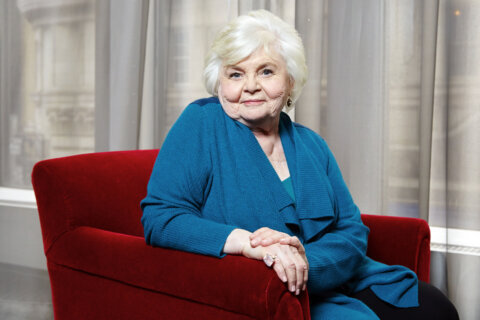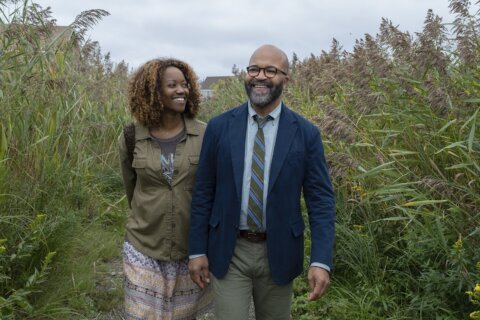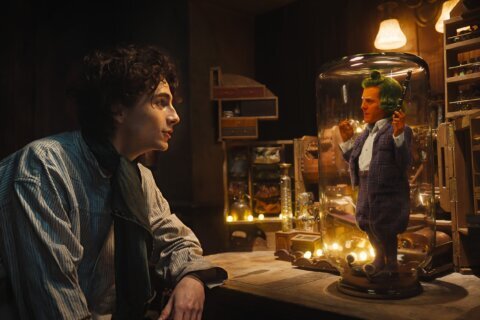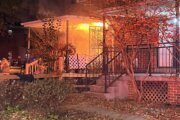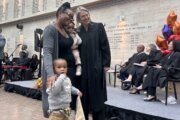WASHINGTON – There’s a scene in “Cinema Paradiso” (1988) where a projectionist screens a film out the window and onto the side of a building.
A similar scene will play out Friday night at D.C.’s Union Market, which is hosting the first-ever drive-in movie theater inside the nation’s capital.
DC Drive-In will show Washington-themed movies on the three-story wall at Union Market on 5th Street Northeast. Cars will simply park in the lot outside the market.
It’s the brainchild of Jon Gann, founder of the D.C. Shorts Film Festival, and Steve Boyle, managing director of Edens, the retail developer who operates Union Market. Boyle already transformed a former drive-in site to the beautiful Angelika Film Center Mosaic in Faifax, Va.
Boyle remembers his first drive-in experience well.
“My first drive-in movie, I’ll never forget, ‘Return of the Pink Panther,'” he says.
“When the credits start, there’s the actual ‘Pink Panther’ cartoon, and then when the actual movie started, I was quite disappointed it wasn’t animated. But I was so entertained by Peter Sellers, that he’s been one of my favorites since that movie, frankly,” Boyle says.
Now, Boyle is kicking off his own drive-in movie series with Stanley Kubrick’s “Dr. Strangelove” (1964), where Sellers memorably plays multiple roles, paving the way for Mike Myers in “Austin Powers” (1997) and Eddie Murphy in “The Nutty Professor” (1996).
Murphy runs for Congress on the walls of Union Market next Friday in “Distinguished Gentleman” (1992), describing Washington as a place where the streets are paved with gold.
July 26 brings “The American President” (1995) — Aaron Sorkin’s tale of presidential prowess and Dupont Circle traffic warnings starring Michael Douglas and Annette Bening.
The series wraps on August 2 with “No Way Out” (1987), starring Kevin Costner and Gene Hackman.
Admission is free, thanks to funding from the D.C. Commission on the Arts and Humanities.
Reserved parking spots open at 7 p.m., public parking begins at 8 p.m. and screenings start at 9 p.m.
The parking lot holds 130 total cars. Seventy spaces have already been reserved, leaving 60 spaces available on a first-come, first-served basis.
Attendees can simply tune their car radios to 88.1 FM to hear the movie audio.
If you can’t get a parking space, you can always sit in the picnic area where the sound will be broadcast over speakers.
Bring a lawn chair or blanket and get there early.
Union Market vendors will serve their trademark food, only now it will be delivered to your car window via car hops on rollerskates.
“Food is entertainment, film is entertainment, they’re both community organizing activities,” Boyle says.
“If you can create these places that give people some sort of emotional attachment, then that becomes an identity of a place,” he says.
The timing is fitting, as this summer marks the 80th anniversary of drive-ins in America. The very first one came to Camden, New Jersey on June 6, 1933 — just two months after the release of “King Kong.”
“The inventor of the drive-in theater was actually an auto parts salesman,” says Jim Kopp, owner of the Family Drive-In Theatre in Stephens City, Va.
“His mother was a little bit too wide to fit comfortably in theater seats. So, he stuck her in the car and put a projector on the top of the car … and he said, well, if she can sit there and watch movies, other folks can, too.”
Kopp shared this bit of trivia with “Jeopardy,” who just devoted an entire Double Jeopardy category to the 80th anniversary on July 4th.
Kopp’s Family Drive-In Theatre has seen strong summer attendance since WTOP featured it last year.
“We had a record Memorial Day weekend, we had a record July 4th,” Kopp says.
Still, Kopp knows it’s not an effort for drive-in movies to make a comeback, rather a chance to preserve what’s left of an American treasure.
Macy’s is highlighting the drive-in as part of its “American Icons” series, hosting events at 10 drive-ins and 10 Macy’s stores to simulate the drive-in experience.
Meanwhile, Honda Motor Co. is holding a contest to donate five digital projectors to drive-ins in need of an upgrade. Kopp says he’s not applying, as his drive-in is already in the midst of a digital conversion, and he knows several friends who are “struggling” to keep their drive-ins alive across the country.
In recent years, there have only been two drive-ins left in the Greater Washington area, both built in 1956 and both situated about an hour and a half from our nation’s capital: The Family Drive-In Theatre in Stephens City, and Bengie’s Drive-In outside Baltimore.
Now, the D.C. Drive-In at Union Market makes it three.
Kopp sends his blessings to the new facility.
“I wish them luck, because I think it’s a great thing that they’re starting,” Kopp says. “They should have a good response to that.”
Boyle is well aware of the potential pitfalls of an inner-city drive-in, from street noise to city lights. Most drive-ins are traditionally built in rural, small-town areas.
“There’s an experience of sitting in a parking lot in a true drive-in that we won’t be able to match, obviously,” he said.
“We’re projecting literally onto the building, so it’s that kind of an experience. We’re trying to augment the experience with the offerings of our vendors and the roller skate service, but there are telephone wires that run by and some of the (view) corridors won’t be so great,” Boyle says.
But he says it’s well worth the attempt.
“We’re hoping that people really just get in the spirit of what we’re trying to accomplish, which is provide a unique event. … We ask people to be patient with us as we work through the bugs on the first one. It is a black and white film, and it will be subtitled, but we’re gonna learn from this showing and knock out any bugs that we encounter so that the next one’s a little bit better,” Boyle says.
There’s no telling what kind of impact this will have on the surrounding community. But the more avenues to show off D.C.’s artistic community, the better.
“We think D.C.’s creative community is vast and not as well known as it should be,” Boyle says.
“It’s a wonderfully creative city that the shadow of government tends to cast over it. And so, we want to celebrate all these really bright, really creative people that play as big a role in D.C. as any other sector. The market is meant to embody that,” Boyle says.
Follow WTOP Film Critic Jason Fraley on Twitter @AboveTheJFray, read his blog at The Film Spectrum or listen every Friday morning on WTOP Radio 103.5 FM.


